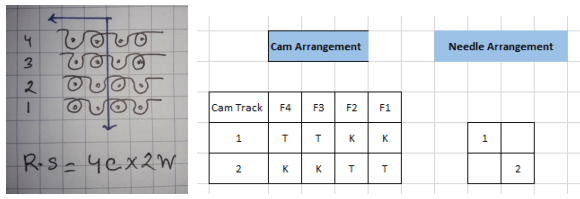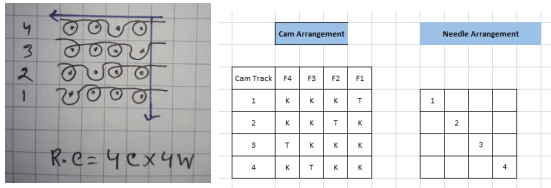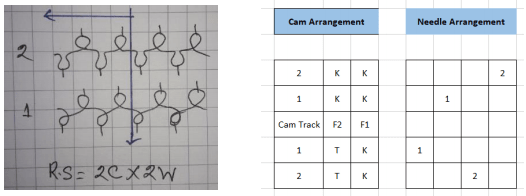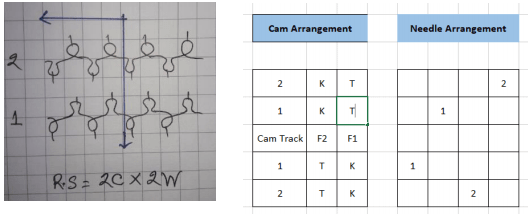Derivatives of Single Jersey and Double Jersey Weft Knitted Structures with Cam and Needle Arrangement
Md. Didarul Islam
Dept. of Textile Engineering
BGMEA University of Fashion & Technology (BUFT), Dhaka
Email: 181-175-801@buft.edu.bd
Single Jersey Derivatives:
Among all weft knitted fabrics, single jersey fabric is the most popular and widely used. Structure is an important measure for any material, especially for fabrics. Fabric structure plays a vital role to increase durability and dimensional stability. The structural modifications are used to a very great extent in designing plain-knit structures by modifying the order of knitting. The plain knit structures can be modified with the following alternatives.
- Knit loop and miss loop
- Knit loop and tuck loop
- Knit Loop, miss loop and tuck loop.
Weft Loc-knit Design:
Weft lock-knit is a knit-miss single jersey structure. So one set of needle is used to produce this structure. The repeat of the structure completes on four courses. Knitting sequence for a repeat as follows:

- First course: Knit on all needles.
- Second course: Miss on all odd number needles and knit on all even number needles.
- Third course: Similar as first course knit on all needles.
- Fourth course: Knit on all odd number needles and miss on all even number needles.
Cross Miss Design:
Cross miss is a miss-knit single jersey structure. So one set of needles are used to produce this structure. The repeat of the structure completes on two courses. Knitting sequence for a repeat as follows:

- First course: Knit on all odd number needles and miss on all even number needles.
- Second course: Miss on all odd number needles and knit on all even number needles.
Birds Eye or Double Cross Miss:
Birds eye is a knit-miss single jersey structure. So one set of needles are used to produce this structure. The repeat of the structure completes on four courses. Knitting sequence for a repeat as follows:

- First course: Knit on all odd number needles and miss on all even number needles.
- Second course: Knit on all odd number needles and miss on all even number needles. Similar as first course.
- Third course: Miss on all odd number needles and knit on all even number needles.
- Fourth course: Miss on all odd number needles and knit onn all even number needles. Similar as third course.
Mock Rib Design:
Mock rib is a knit-miss single jersey structure. So one set of needles are used to produce this structure. The repeat of the structure completes on two courses. Knitting sequence for a repeat as follows:

- First course: Miss on first three needles and knit on second or next three needles.
- Second course: It is just opposite of the first course i.e. knit on first three needles and miss on second three needles.
Single Cross Tuck:
Single cross tuck is a knit-tuck single jersey structure. So one set of needles are used to produce this structure. The repeat of the structure completes on two courses. Knitting sequence for a repeat as follows:

- First course: Knit on all odd number needles and tuck on all even number needles.
- Second course: It is opposite of the first course i.e. tuck on all odd number needles and knit on all even number needles.
Double Cross tuck or Polo Pique Design:
Polo pique is a knit-tuck single jersey structure. So one set of needles are used to produce this structure. It is a very popular structure to produce cut and sew knit wear. The prominency of the design appears on the back side of the fabric. The repeat of the structure completes on four courses. Knitting sequence for a repeat as follows:

- First course: Knit on all odd number needles and tuck on all even number needles.
- Second course: Knit on all odd number needles and tuck on all –even number needles, which is similar as the first course.
- Third course: Tuck on all odd number needles and knit on all even number needles.
- Fourth course: Tuck on all odd number needles and knit on all even number needles, which is similar as the previous third course.
Single Lacoste or Fred Perry Design:
Single lacoste is a knit-tuck single jersey structure. So one set of needles are used to produce this structure. It is also a very popular structure to produce cut and sew knit wear. The prominency of the design appears on the back side of the fabric. The repeat of the structure completes on four courses. Knitting sequence for a repeat as follows:

- First course: Knit on all odd number needles and tuck on all even number needles.
- Second course: Knit on all needles.
- Third course: Tuck on all odd number needles and knit on all even number needles, which is opposite of the first course.
- Fourth course: Similar as second course knit on all needles.
Double Lactose Design:
Double lacoste is a tuck-knit single jersey structure. So one set of needles are used to produce this structure. It is also a very popular structure to produce cut and sew knitwear. The prominency of this design near to the single lacoste fabric. The repeat ofthe structure completes on six courses. Knitting sequence for a repeat as follows:

- First course: Knit on all odd number needles and tuck on all even number needles.
- Second course: Same as first course i.e. Knit on all odd number needles and tuck on all even number needles.
- Third course: Knit on all needles.
- Fourth course: Tuck on all odd number needles and knit on all even number needles, which is opposite of the first course.
Simple Crepe Design:
It may be tuck-knit or miss-knit single jersey structure. So one set of needles are used to produce this structure. The repeat of the structure completes on four courses. Knitting sequence for a repeat as follows:

- First course: Tuck on first needle and knit on all rest of the needles.
- Second course: Tuck on second needle and knit on all rest of the needles.
- Third course: Tuck on fourth needle and knit on all rest of the needles.
- Fourth course: Tuck on third needle and knit on all rest of the needles.
Cellular Blister or Popcorn Design:
It is a tuck-knit single jersey structure. So one set of needles are used to produce thestructure. The prominency of the design appears on the back side of the fabric. The repeat of the structure completes on eight courses. Knitting sequence for a repeat as follows:

- First course: Tuck on first two needles and knit on second or next two needles.
- Second course: Similar as first course.
- Third course: Similar as first course.
- Fourth course: Similar as first course i.e. Tuck on first two needles and knit on next two needles.
- Fifth course: Knit on first two needles and tuck on second or next two needles.
- Sixth course: Similar as fifth course.
- Seventh course: Similar as fifth course.
- Eighth course: Similar as fifth course i.e. Knit on first two needles and tuck on second two needles.
Double Jersey Derivatives based on Rib Structure:
A generic name applied to a range of knitted fabrics made on a rib or interlock basis, the construction of which is often designed to reduce the natural extensibility of the structure. The term is generally confined to fabrics knitted on machines of E10 gauge or finer and it may be classified as ether non-jacquard or jacquard double jersey.
Swiss Double Pique:
Double pique is a double jersey fabric made on a rib basis, using a selection of knitted loops and floats. Double pique is also known as wevenit, rodier, and overnit. The two most important sequences are known as Swiss double pique and French double pique respectively. Knitting sequences of Swiss double pique is shown in the following figure:

1. First course: Cylinder needles- all are produce knit loop.
Dial needles- odd number needles produce knit loop and even number needle produce miss loop.
2. Second course: Cylinder needles- all are produce miss loop.
Dial needles- same as first course.
3. Third course: Cylinder needles- same as first course.
Dial needles – odd number needles produce miss loop and even number needle produce knit loop.
4. Fourth course: Cylinder needles- all are produce miss loop.
Dial needles- same as third course.
Half cardigan or Royal Rib:
It is a rib based structure in which a great number of tuck stitches are added to make the fabric heavy, wide and soft. From the below notation diagram it is clear that two knitting sequences are required to produce one repeat of this type of fabric. A special effect is produced when one half of the cardigan repeat is substituted for a regular 1 x 1 rib structure. The new fabric is called a “Half Cardigan” and is produced according to the knitting notation system illustrated in the following figure. One side of the fabric, in this case the reverse side, is produced with tuck stitches and therefore looks like a “Cardigan”. The loops of the other side acquire a very rounded and attractive shape which is very typical for this structure.
The Knitting sequence for a repeat as follows:

- First course: Regular 1×1 rib structure.
- Second course: Tuck loop formed by the all needles of one bed and knit loop formed by the all needles of other bed.
Full Cardigan Rib or Polka Rib:
It is another variation of the 1×1 rib structure. In this case, even more tuck stitches are introduced which makes the fabric wider, heavier, bulkier and less flexible then the half cardigan or the usual 1×1 rib. Contrary to the previous example the full cardigan is symmetric on both sides. From the below notation diagram it is clear that two yarns are inserted into the fabric in order to complete one full course i.e. loops on the one needle bed and loops on the other needle bed. The two courses which make the “Cardigan” repeat are illustrated in the above needle notation system.
The Knitting sequence for a repeat as follows-

- First course: Tuck loop formed by the all needles of back bed and knit loop formed by the all needles of front bed.
- Second course: Tuck loop formed by the all needles of front bed and knit loop formed by the all needles of back bed.
Because of the large number of tuck stitches, both Cardigan and Half Cardigan are very bulky, in comparison with other knit structures. They are sometimes very fashionable and are used for heavy outerwear such as sweater.
Half Milana Rib:
A weft-knitted rib-based fabric, consisting of one row of 1×1 rib and one row of plain knitting made on either set of needles. The appearance and characteristics of the fabric are related to the ratio of the course lengths of first (1) and second (2). The Knitting sequence for a repeat as follows-

- First course: Regular 1×1 rib structure.
- Second course: Plain structure, all needle of one bed is active and needles of other bed is inactive.
Single Pique or Cross Tuck Interlock:
It was one of the first to be produced, by placing tuck cams in the dial at every third feeder. The tuck stitches throw the fabric out approximately 15% wider than normal interlock to a satisfactory finished width of over 60″, they break up the surface uniformity and help to mask feeder stripiness but they also increase fabric weight.
Single pique is a tuck-knit interlock structure. So interlock needle gating system is used to produce this structure. Long and short needles in dial and cylinder, long needles facing short needles and vice-versa. The repeat of the structure completes on six feeders. Knitting sequence for a repeat as follows:

- First feeder: Knit on all short cylinder needles and tuck on all short dial needles.
- Second feeder: Knit on all long cylinder and dial needles.
- Third feeder: Knit on all short cylinder and dial needles.
- Fourth feeder: Knit on all long cylinder needles and tuck on all long dial needles.
- Fifth feeder: Knit on all short cylinder and dial needles.
- Sixth feeder: Knit on all long cylinder and dial needles.
References:
- Understanding Textiles for a Merchandiser By Shah Alimujjaman Belal
- Knitting Technology by David J Spencer
